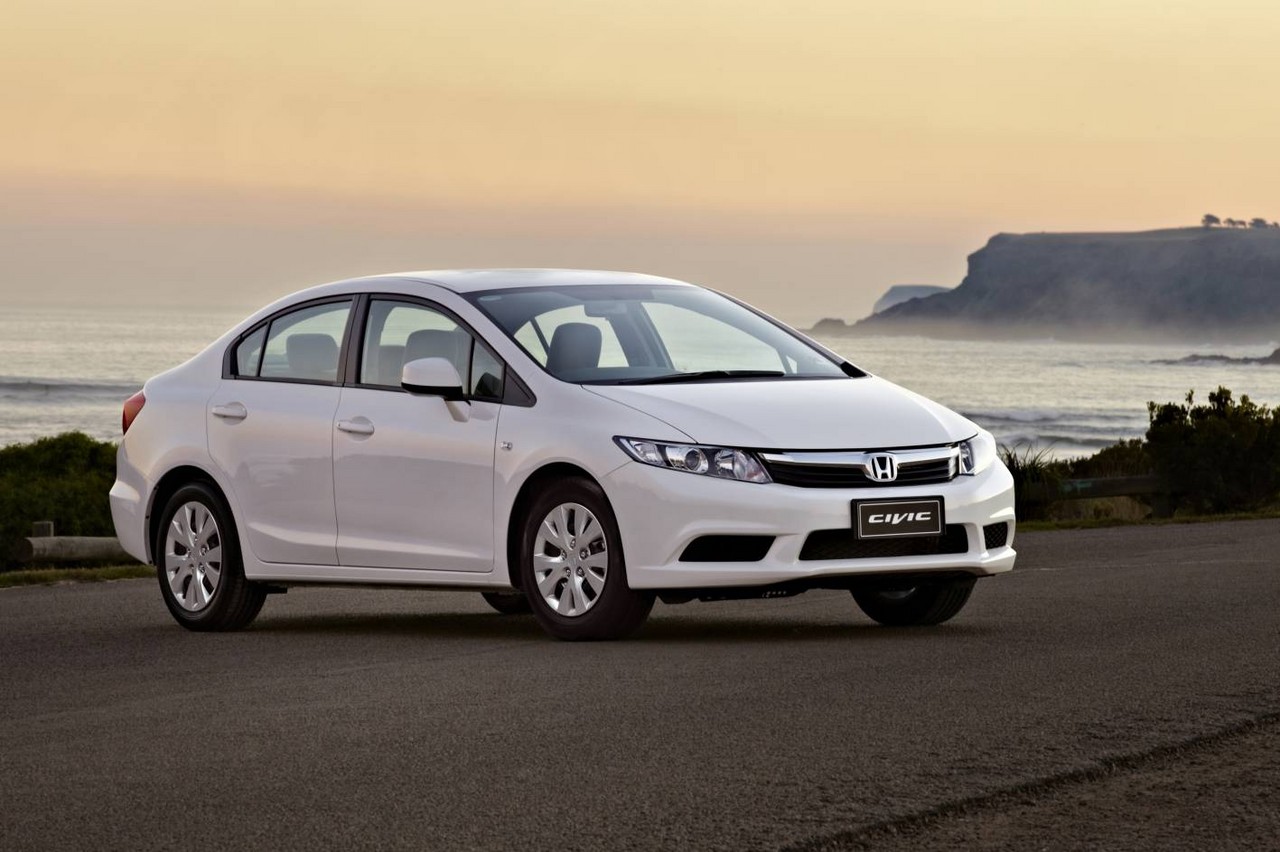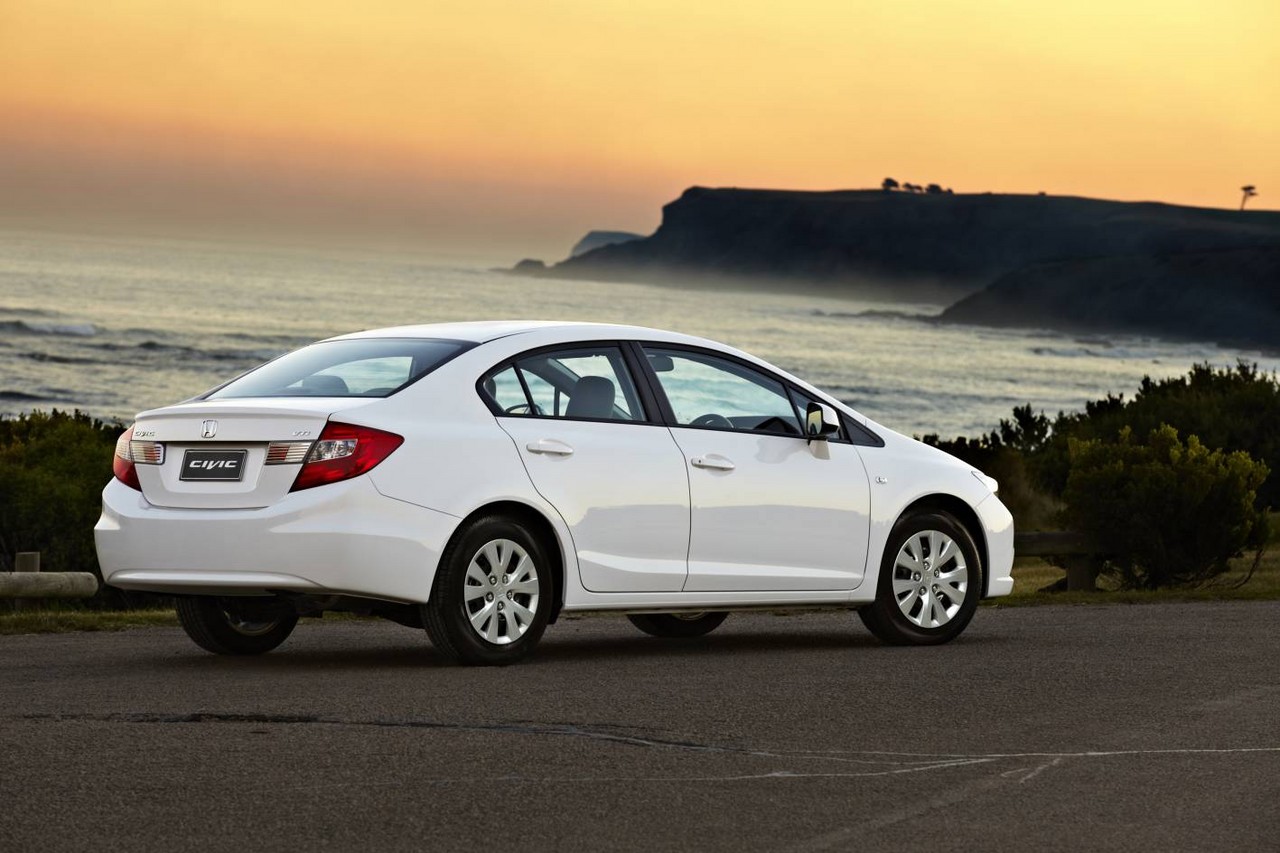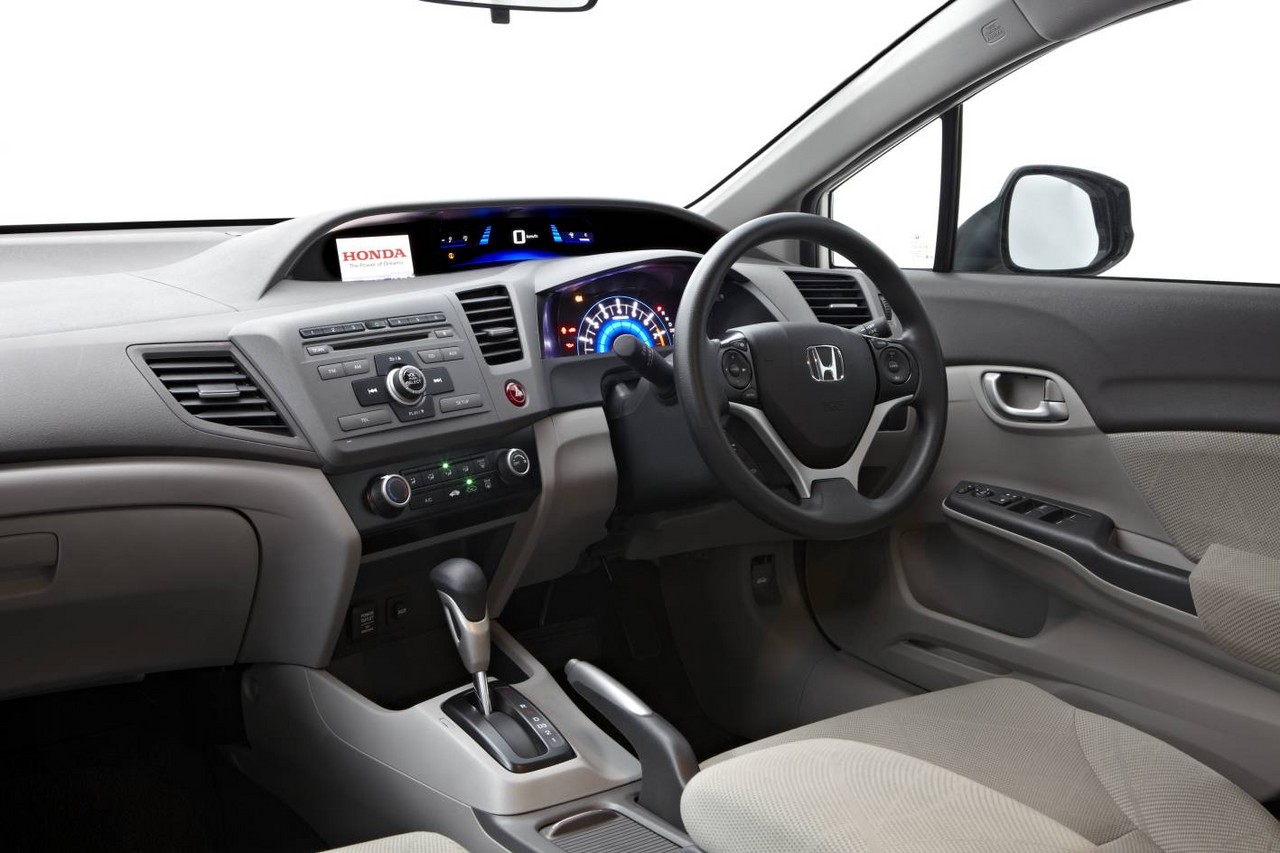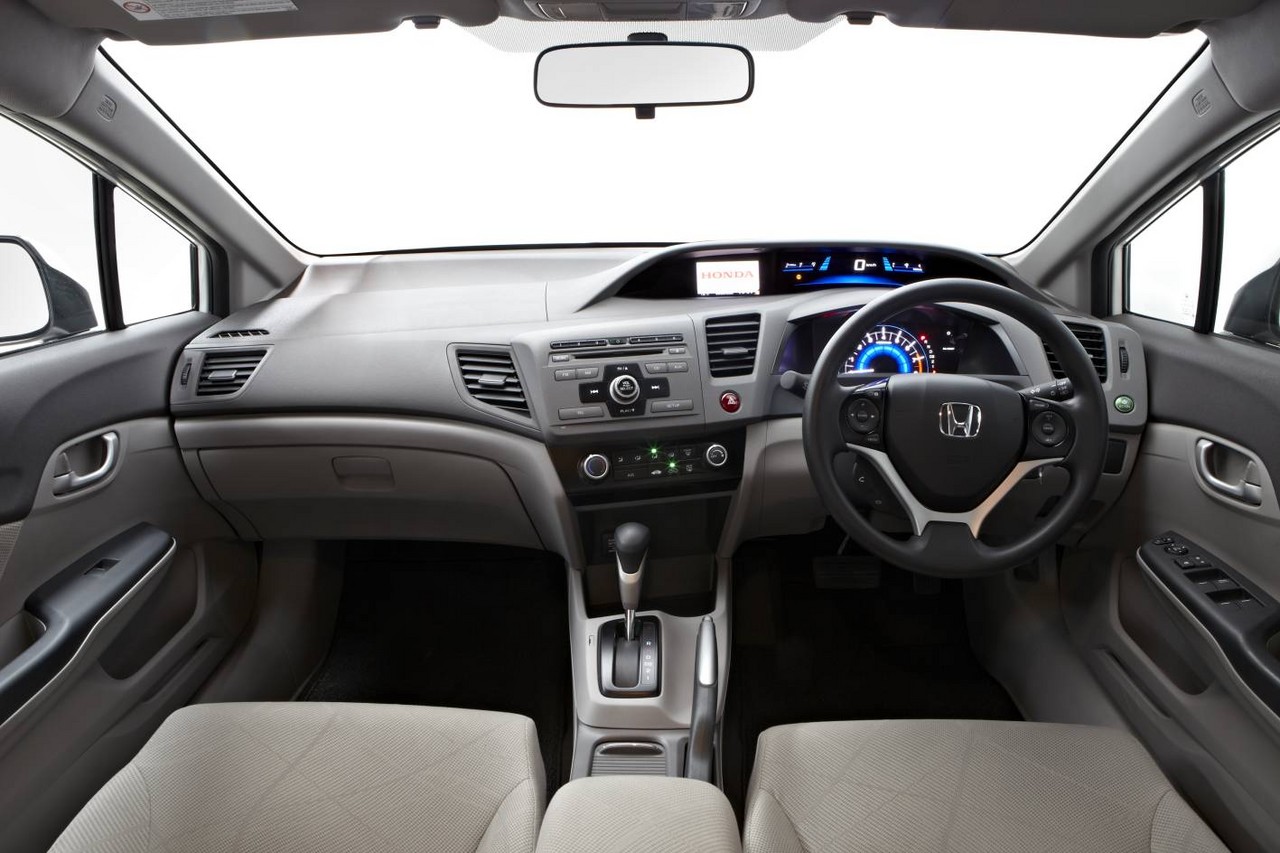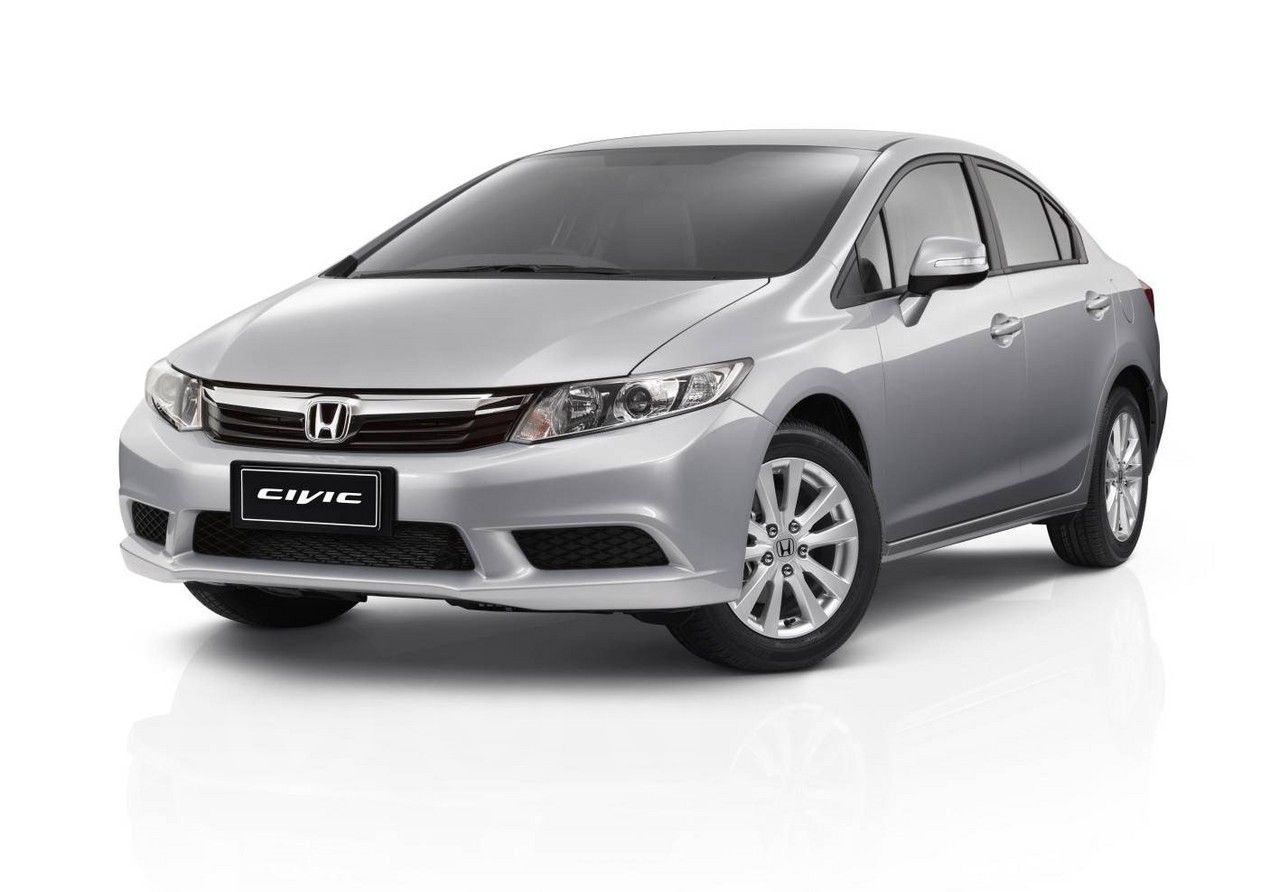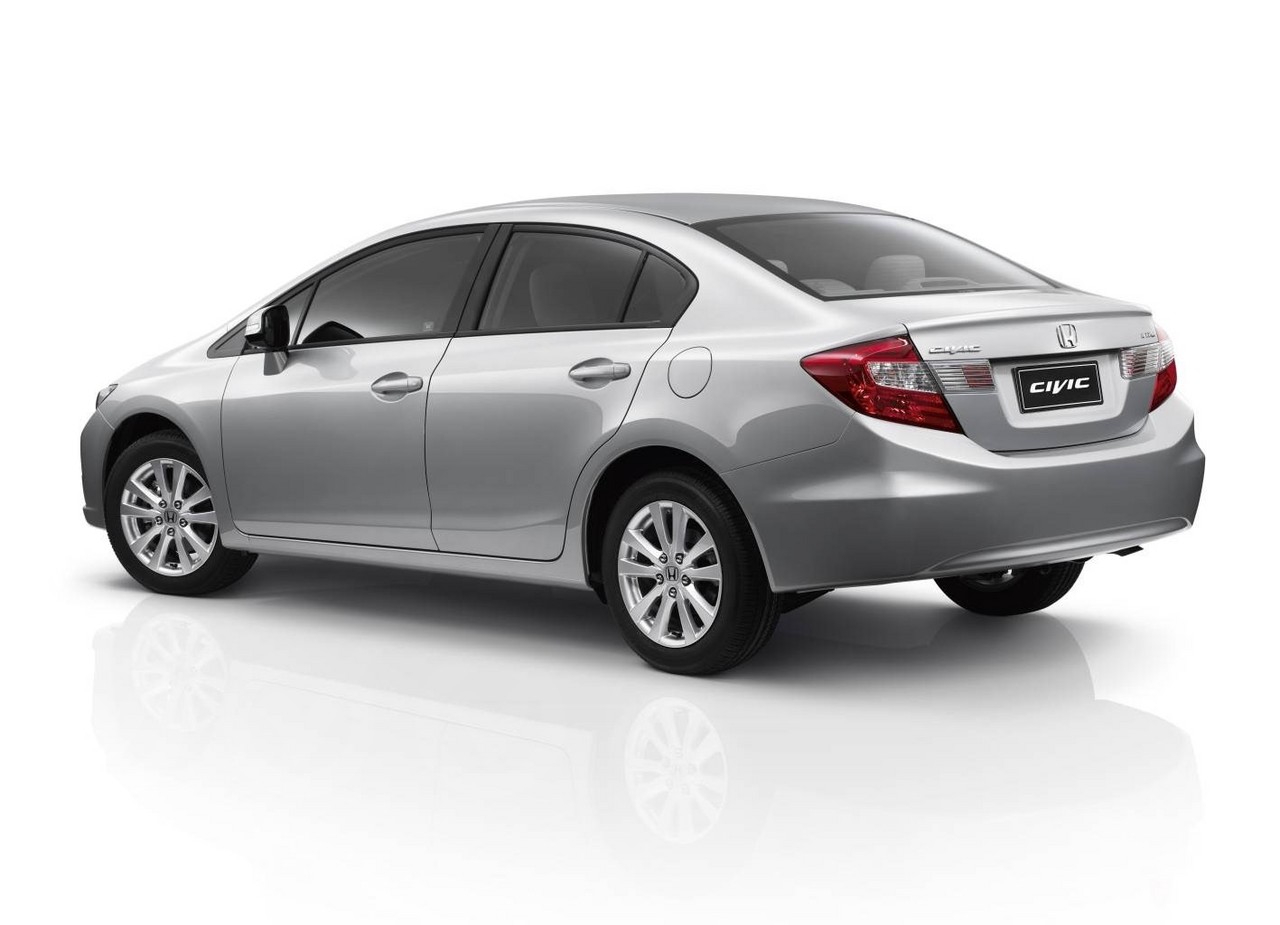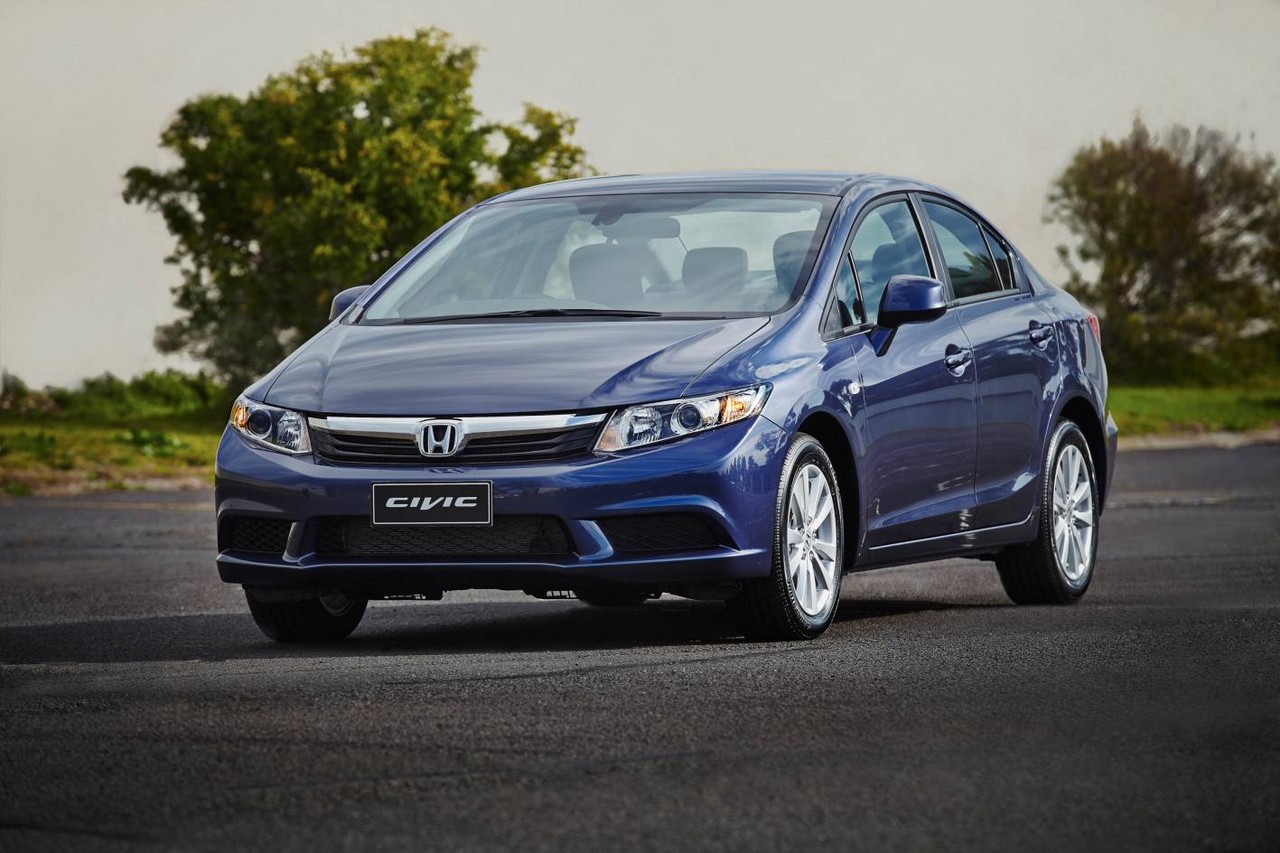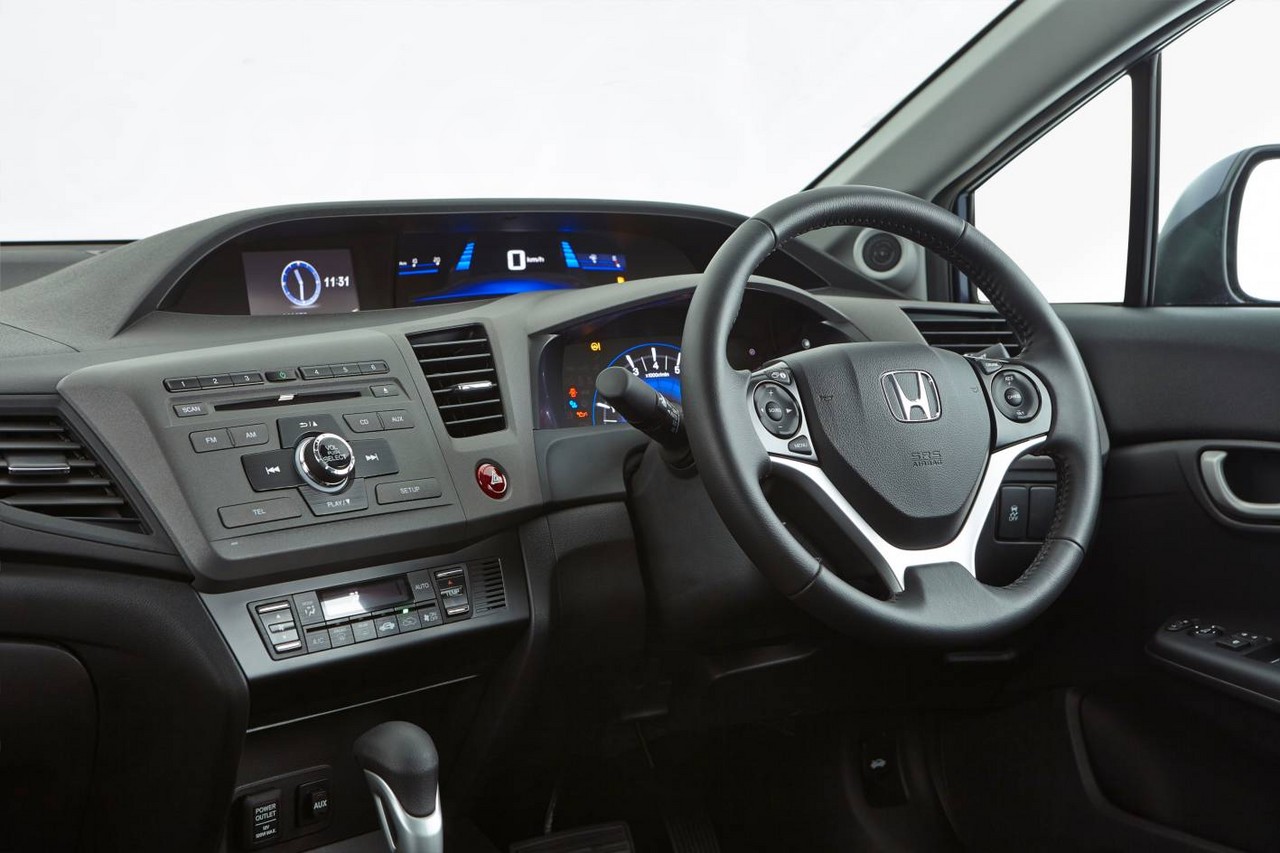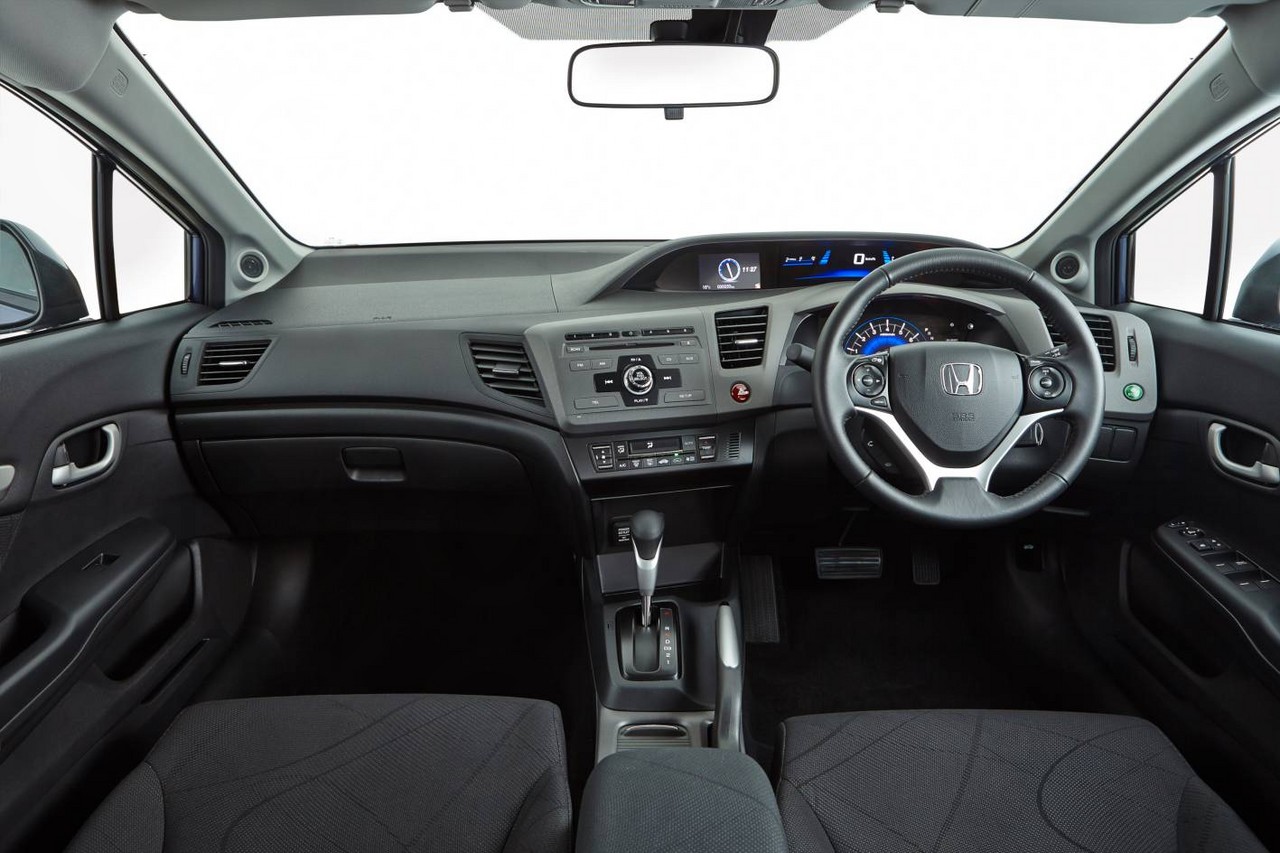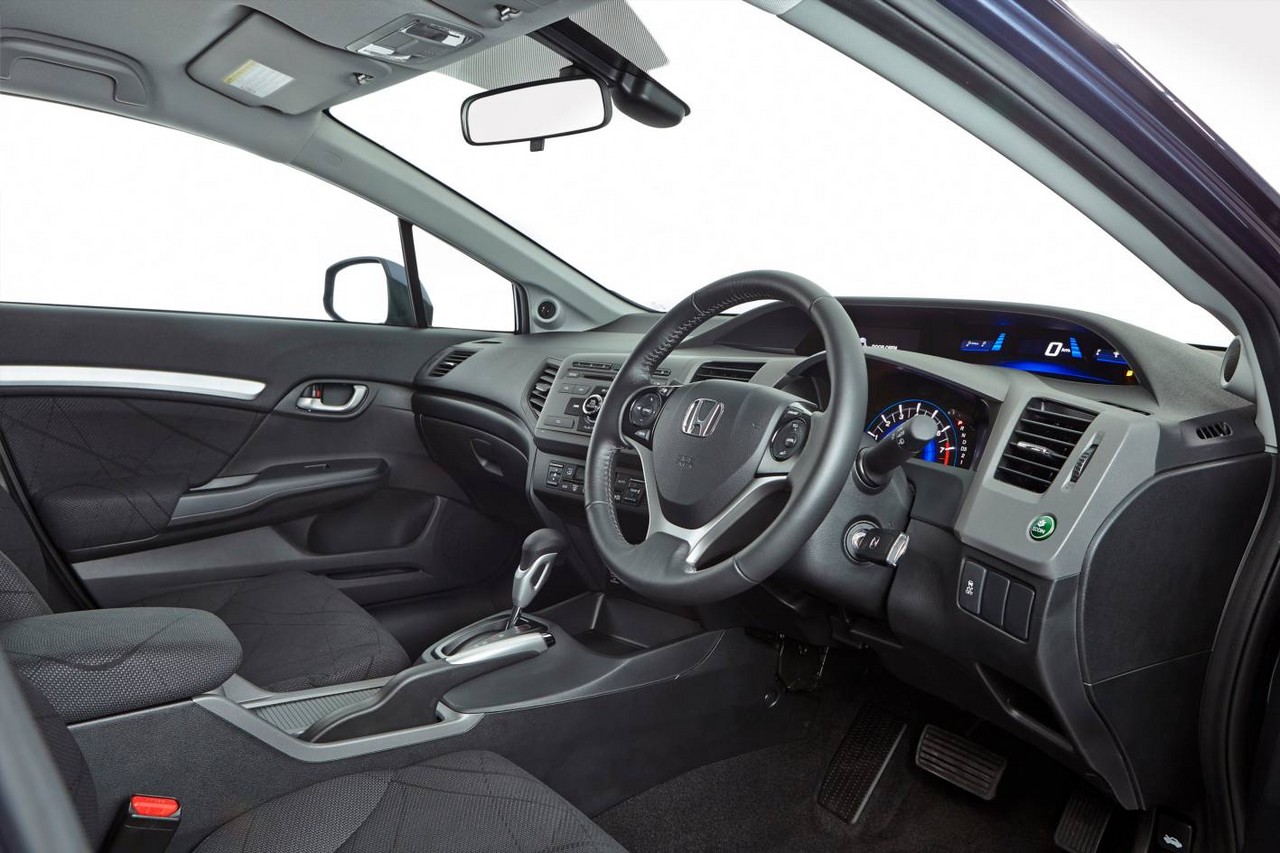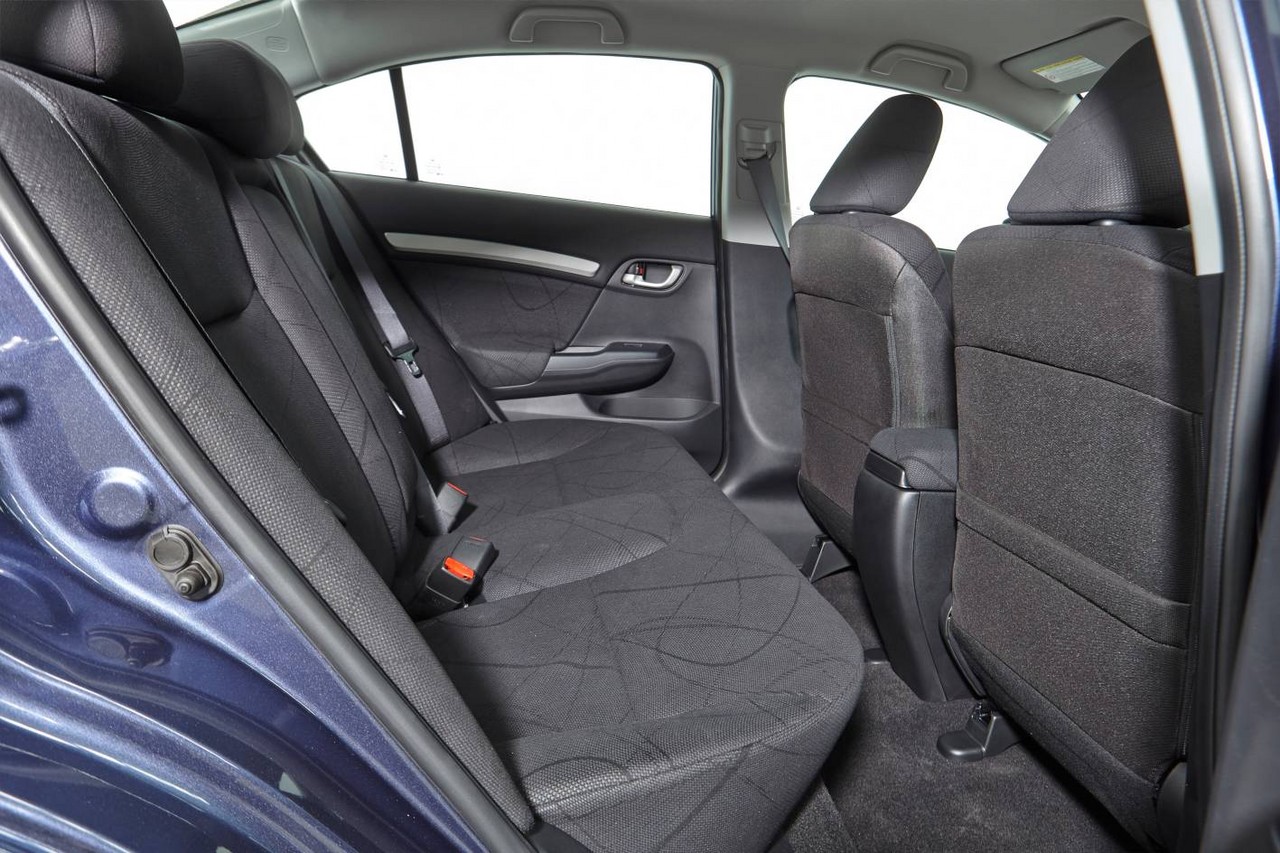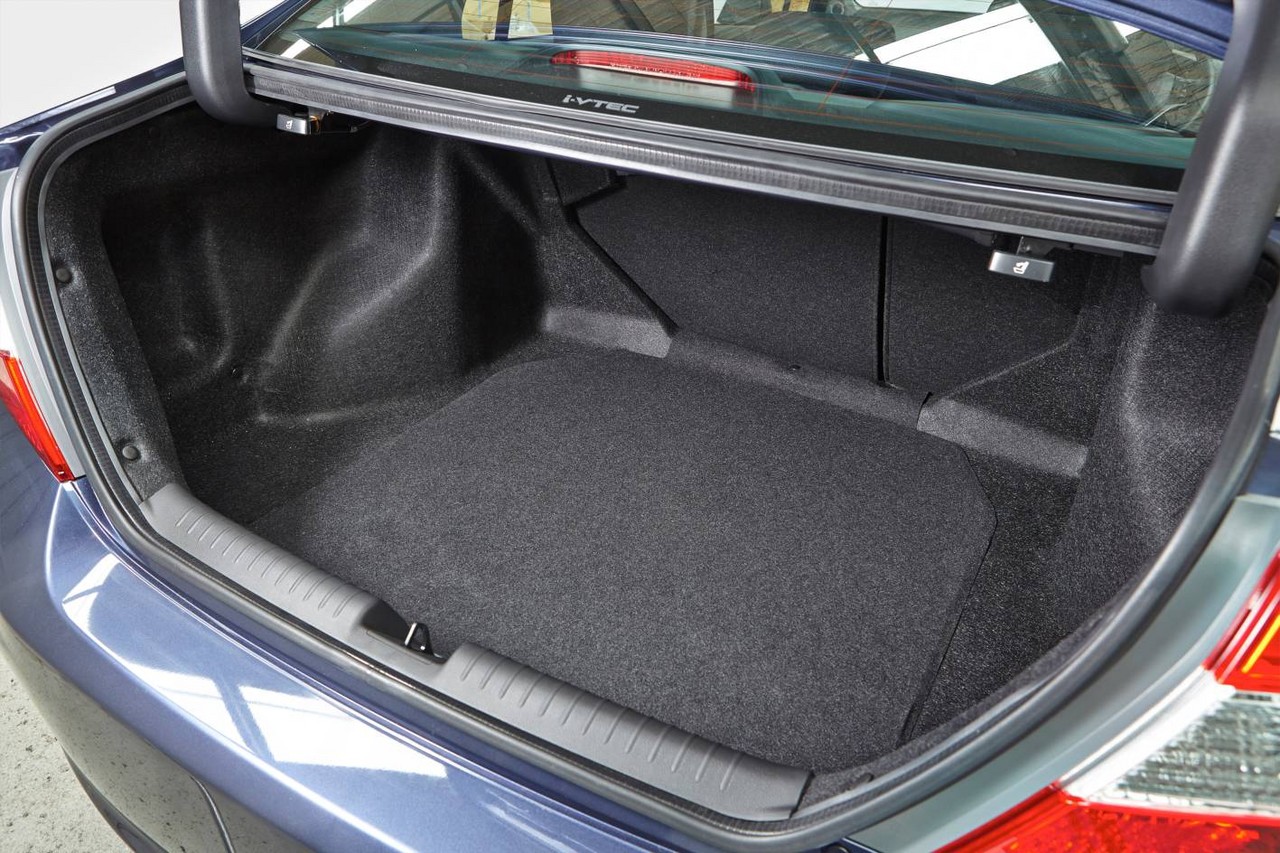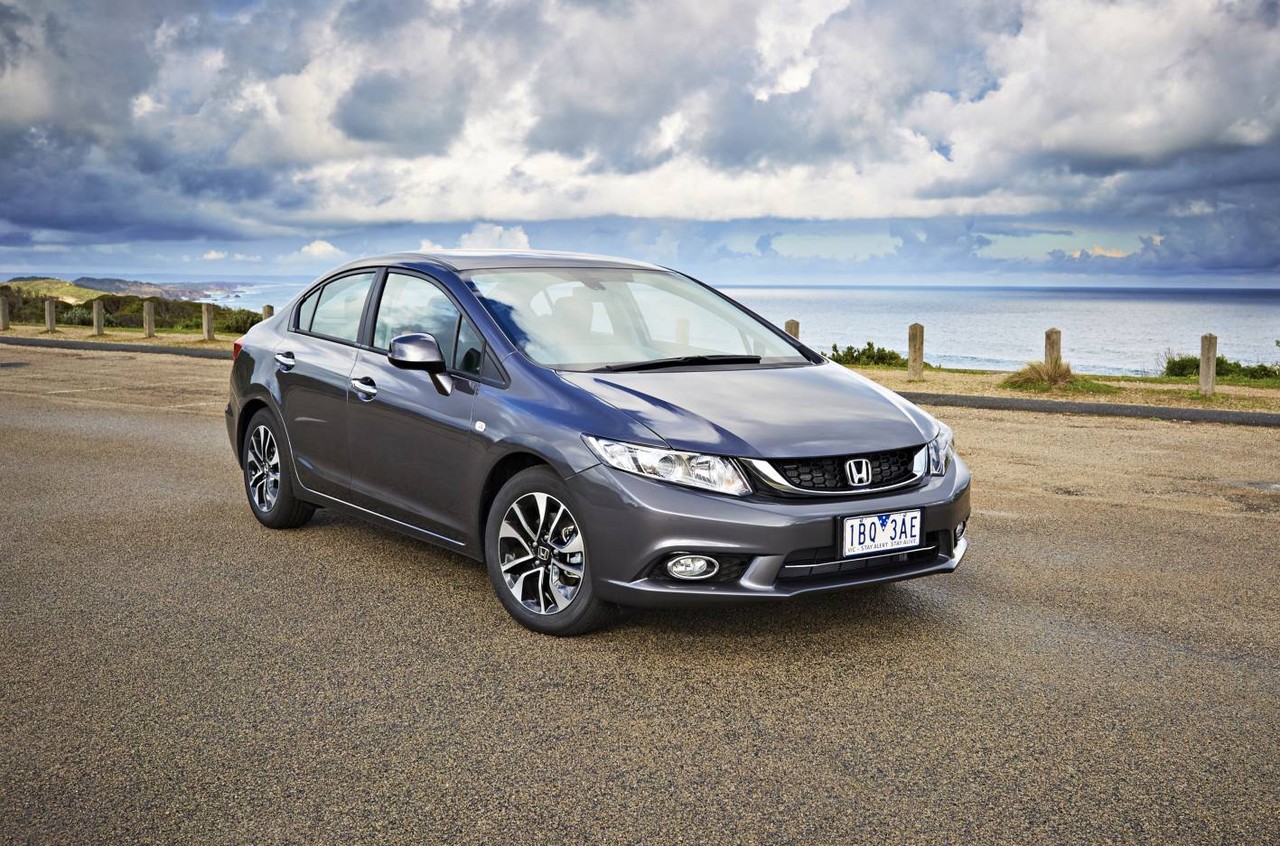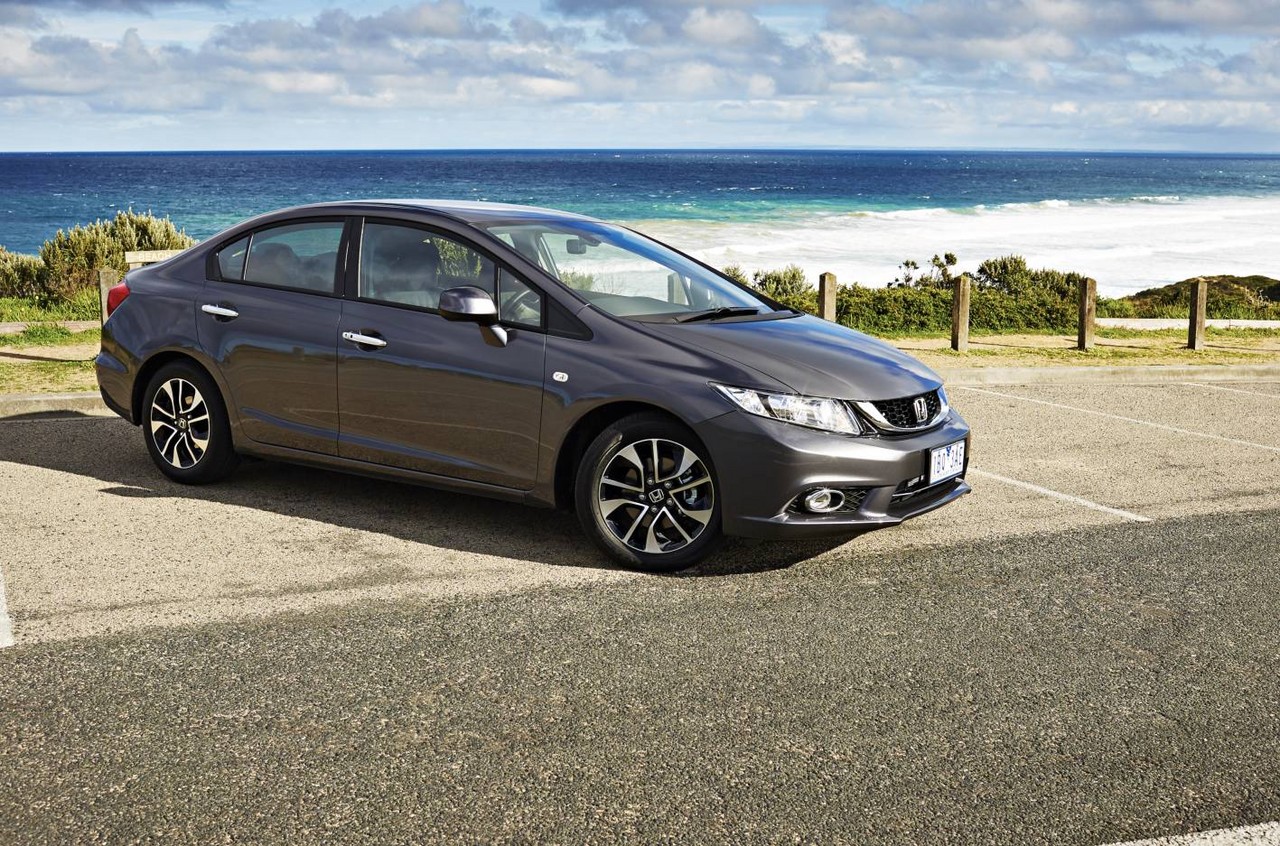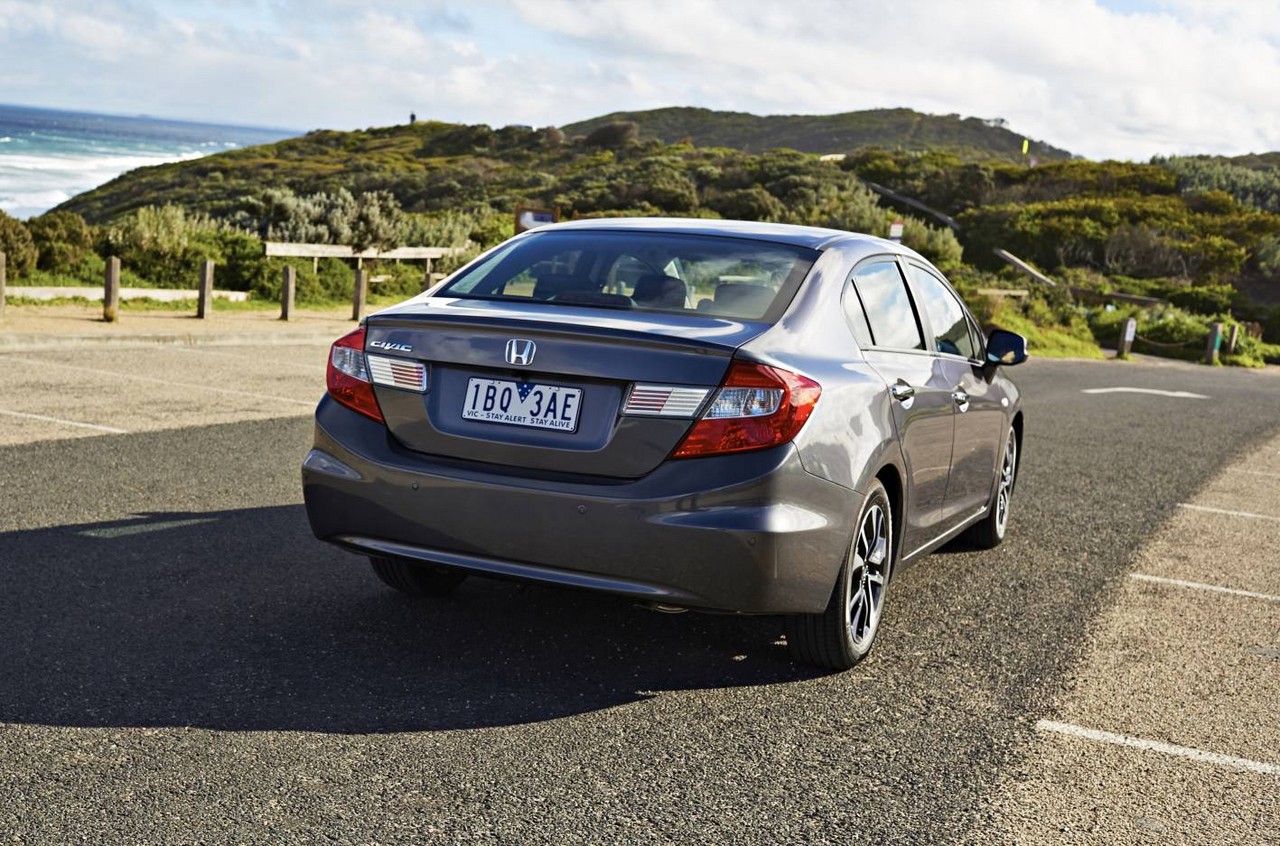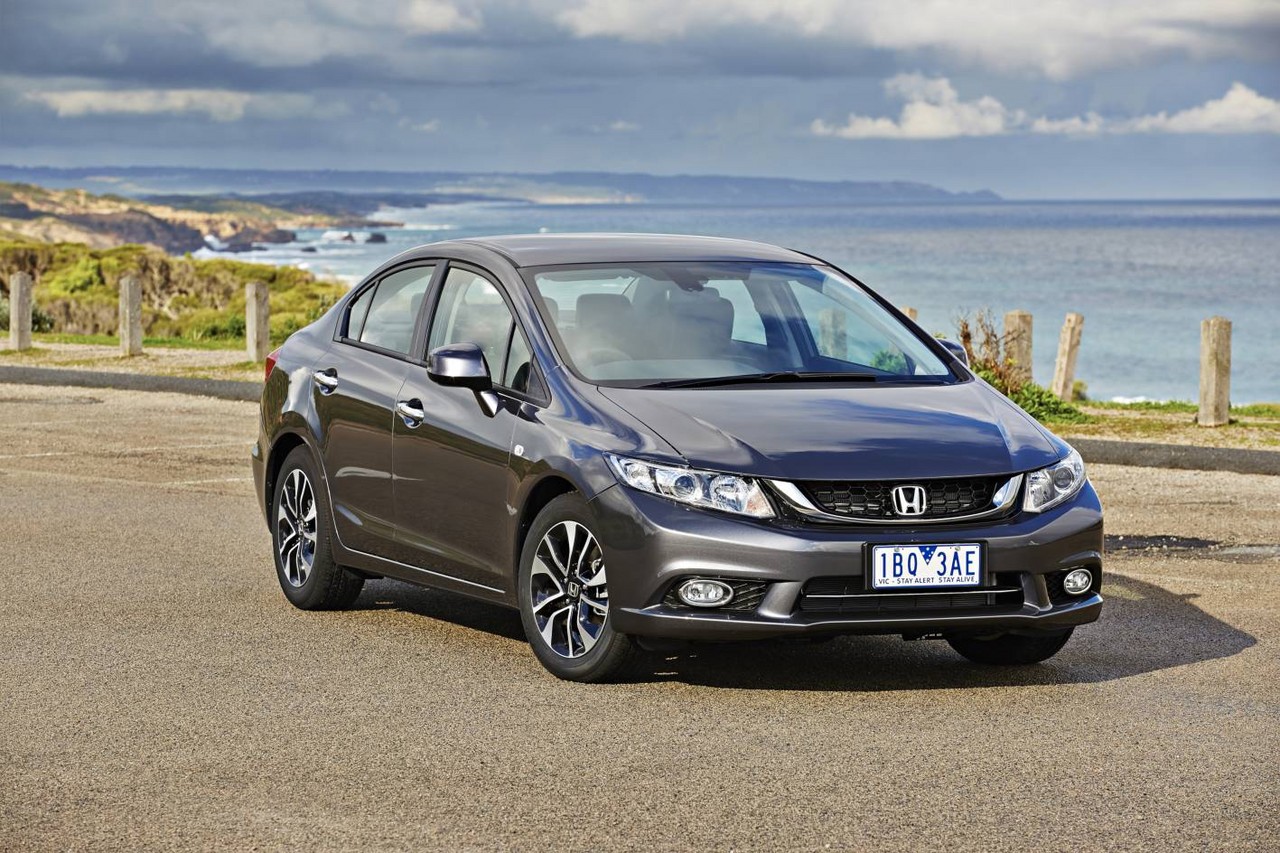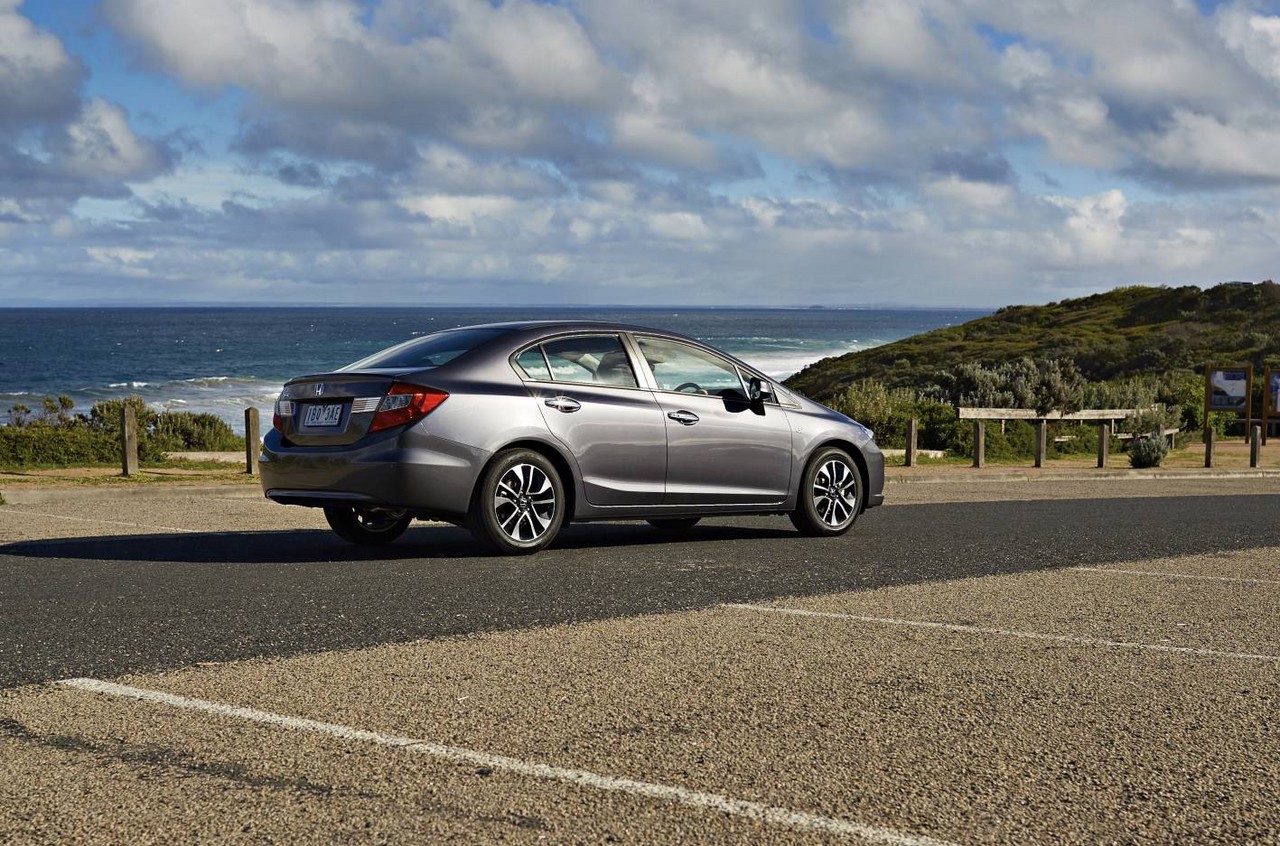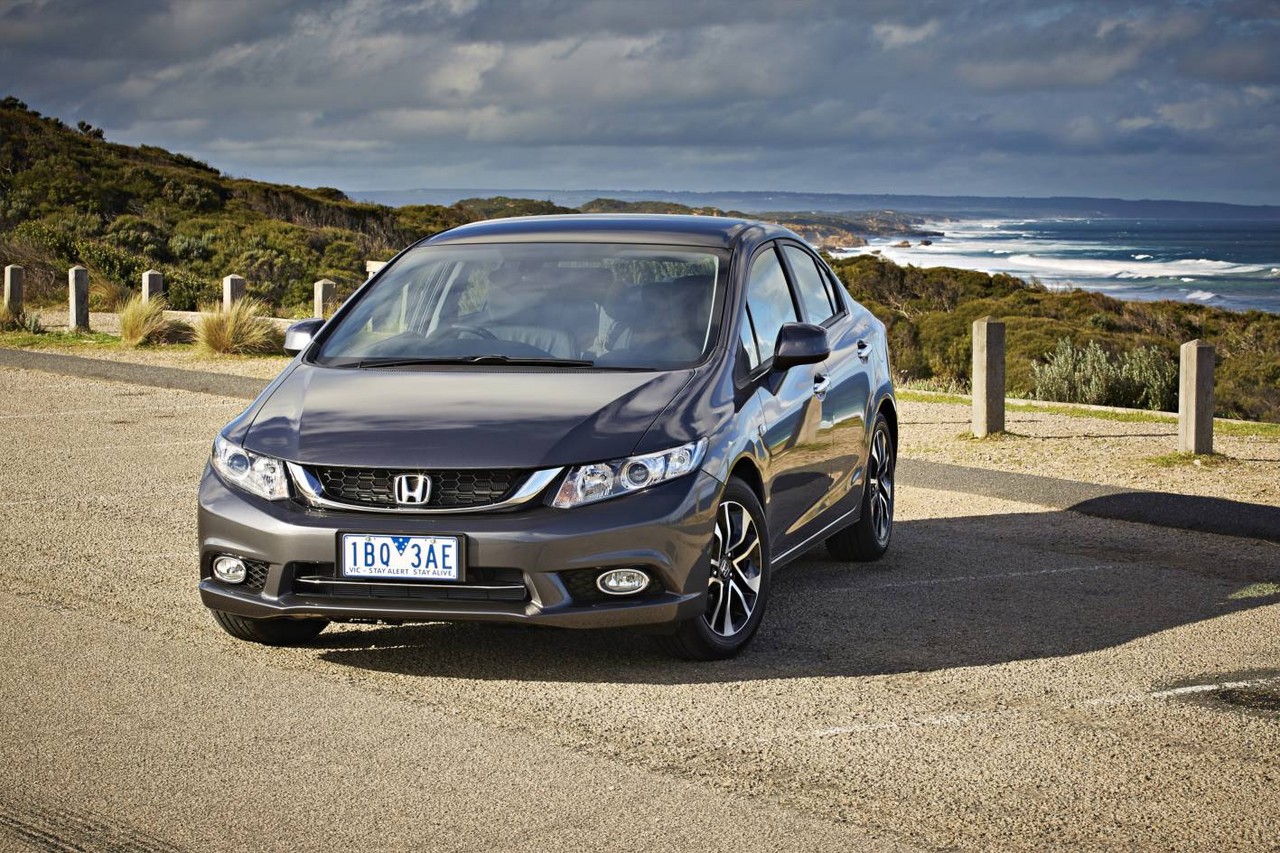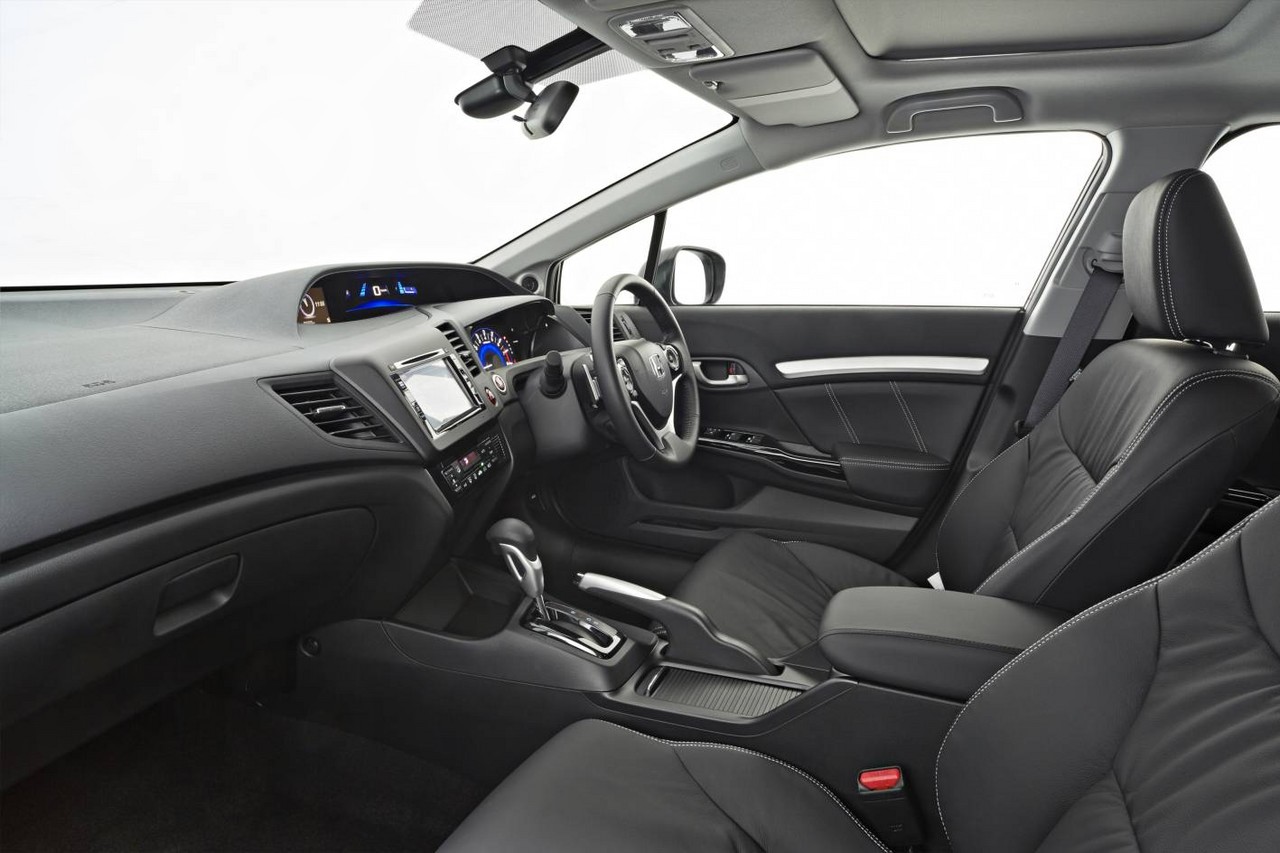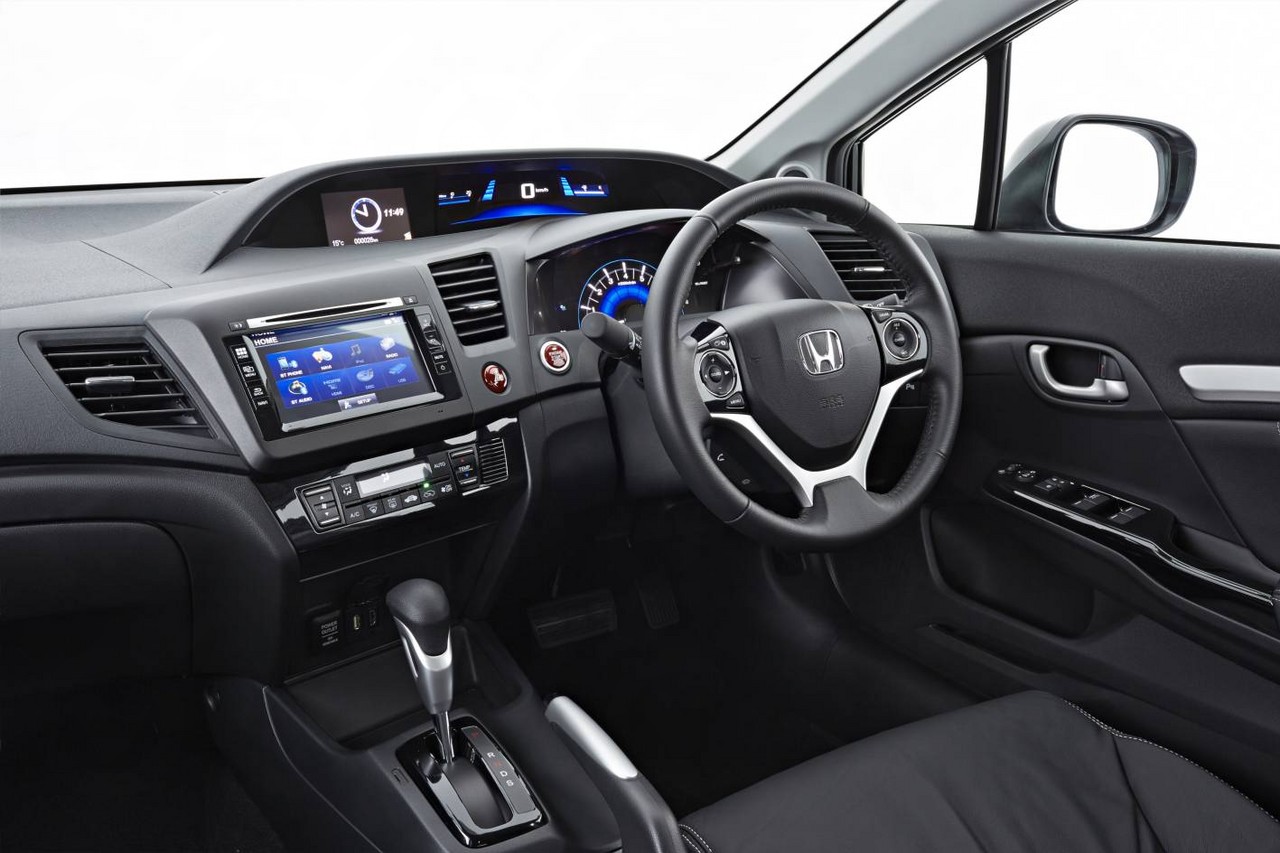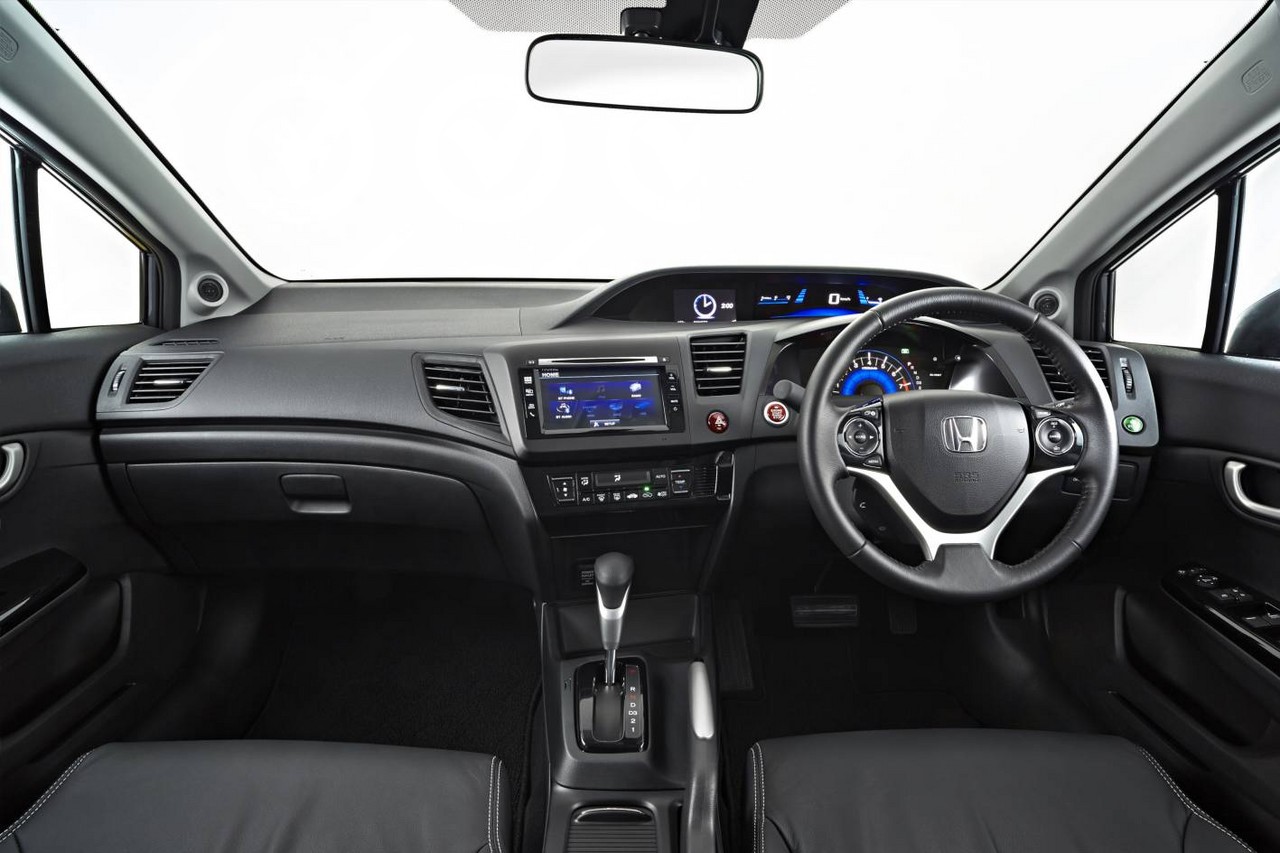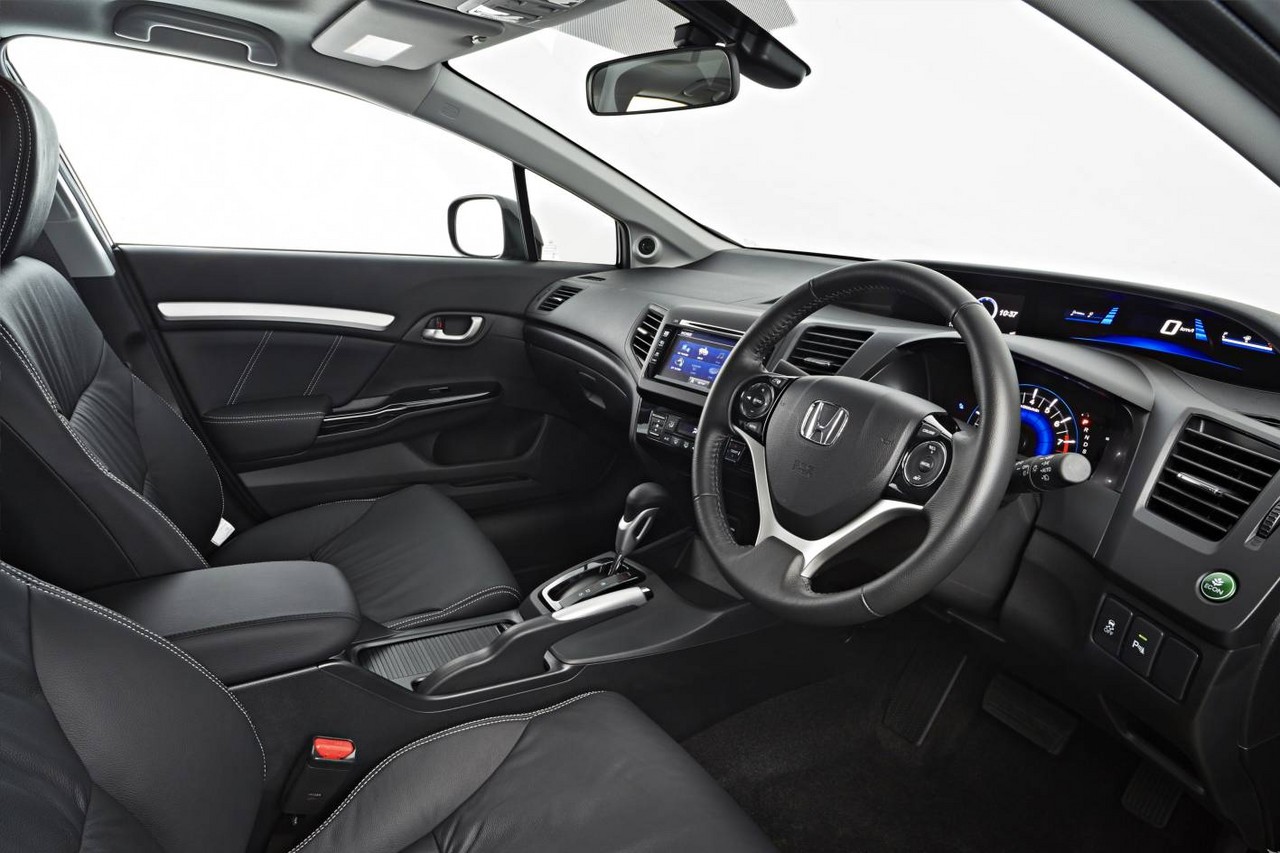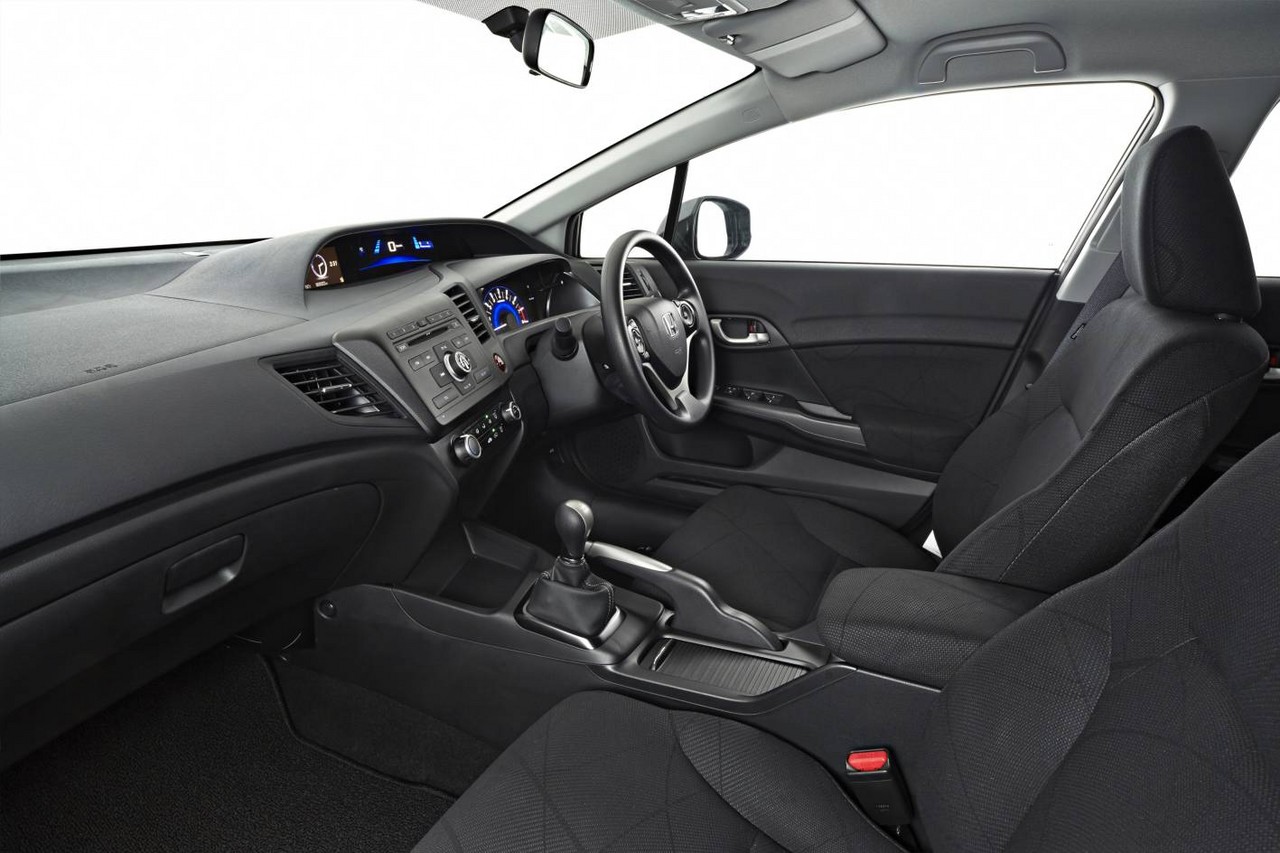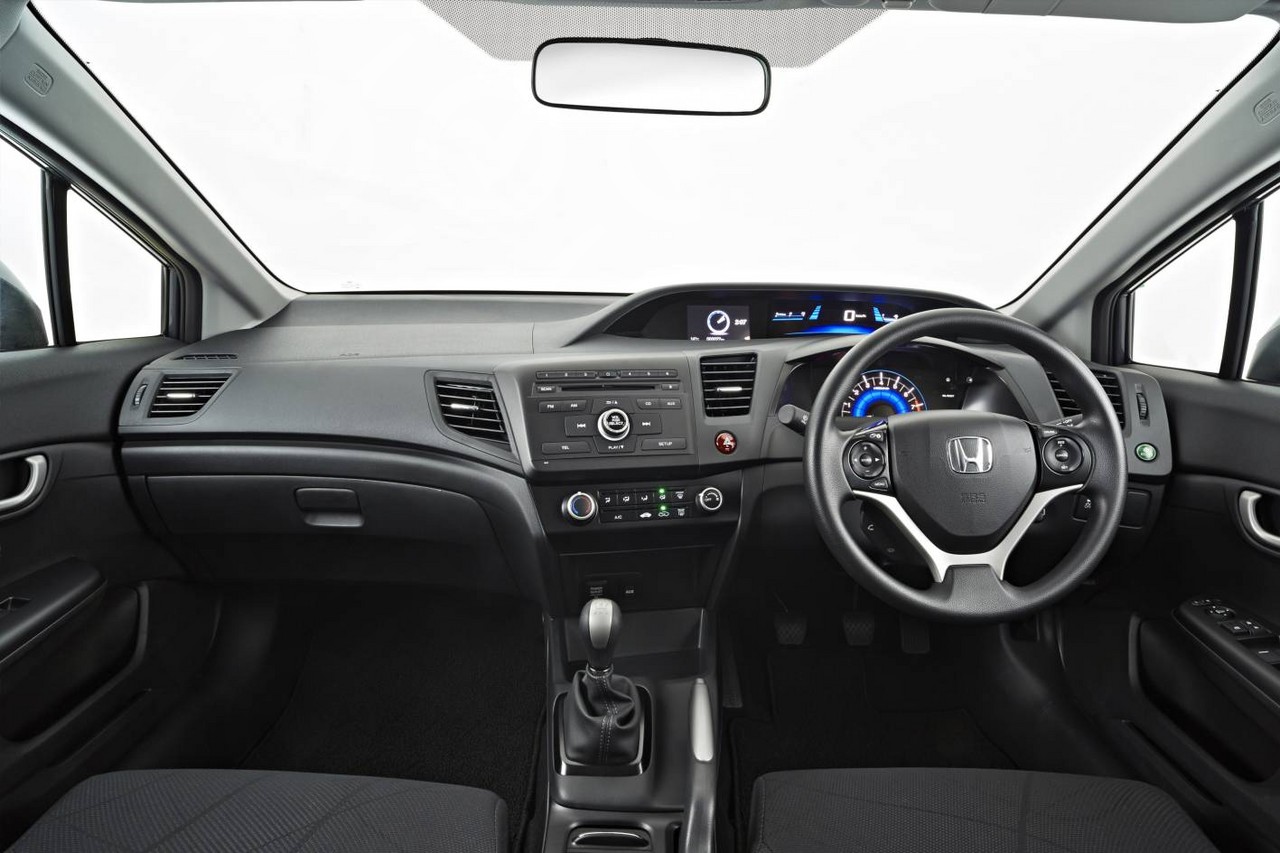
- Willing 1.8- and 2.0-litre engines
- High standard of interior fit and finish
- Spacious interior and boot
- Affordable retail pricing for entry-level variants
- Generally comfortable ride…
- though suspension for Civic Sport lacks compliance
- Outdated five-speed transmissions
- Vague steering
- Outclassed by Volkswagen Mk.7 Golf and Mazda BM Mazda3
Honda FB2.I and FB3.I Civic Sedan (2012-14)
Overview
Released in February 2012, the ninth-generation Honda Civic sedan range initially consisted of two Japanese-built sedan variants, the VTi-L and Sport, which were powered by 1.8- and 2.0-litre four-cylinder petrol engines respectively. In July 2012, however, the Japanese-built sedans were replaced with Thai-built vehicles – marketed by Honda Australia as ‘Series II’ Civics – and the sedan range was expanded with VTi and VTi-LN variants; the VTi-L also became auto-16ly.
As per the table below, transmissions consisted of five-speed manual and five-speed automatic units.
R18A1 and R20A1 engines
For the FB2 Civic, the 1.8-litre R18A1 four-cylinder petrol engine had an aluminium-alloy block and cylinder head, a single overhead camshaft (chain-driven), four valves per cylinder, a variable length intake manifold, drive-by-wire throttle control and a compression ratio of 10.6:1. The engine also featured Honda’s i-VTEC (Intelligent Variable Valve Timing and Lift Electronic Control) system which used two distinct camshaft profiles to vary intake valve timing and lift for low RPM (1500-3500 rpm) and high RPM (5200-7000 rpm) operations.
For the FB3 Civic, the 2.0-litre R20A1 had the same properties as the 1.8-litre unit though stroke was increased to 96.9 mm for its increased capacity.
Dimensions and body
Compared to its FD1/FD2 Civic sedan predecessor, the FB2/FB3 Civic sedan was 10 mm shorter (at 4540 mm), 5 mm wider (1755 mm), the same height (1435 mm), and had a 30 mm shorter wheelbase (2670 mm). Although the FB2/FB3 Civic had a lighter body, static and dynamic rigidity increased by 10 per cent – this was partially attributable to the use of high-strength steel increasing from 50 per cent to 55 per cent.
Steering and suspension
The FB2/FB3 Civic sedan had speed-sensitive electric power-assisted steering, MacPherson strut front suspension and multi-link rear suspension.
| Variant | Engine | Trans. | Years | Peak power | Peak torque |
|---|---|---|---|---|---|
| VTi | 1.8-litre petrol I4 | 5sp man., 5sp auto |
2012-14 | 104 kW at 6500 rpm | 174 Nm at 4300 rpm |
| VTi-L | 1.8-litre petrol I4 | 5sp man. | 2012 | 104 kW at 6500 rpm | 174 Nm at 4300 rpm |
| 5sp auto | 2012-14 | ||||
| VTi-LN | 1.8-litre petrol I4 | 5sp auto | 2012-14 | 104 kW at 6500 rpm | 174 Nm at 4300 rpm |
| Sport | 2.0-litre petrol I4 | 5sp auto | 2012-14 | 114 kW at 6500 rpm | 190 Nm at 4300 rpm |
Safety equipment
Standard safety equipment for the FB2/FB3 Civic included dual front airbags, front side airbags, full-length curtain airbags, ABS, electronic brake force distribution, brake assist, electronic stability control, traction control and front seatbelts with pretensioners and load limiters.
ANCAP crash testing
In ANCAP crash testing , the FB2/FB3 Civic sedan received a five star adult occupant protection rating with a score of 34.91 out of 37. In the offset crash test, there was a slight risk of serious chest and leg injury for the front occupants. In the side impact and pole tests, however, maximum points were awarded.
Features: Civic VTi, VTi-L and Sport
Standard features for the Civic VTi included 15-inch steel wheels, a four speaker sound system with MP3/WMA-compatibility, auxiliary inputs (USB/iPod) and Bluetooth audio streaming and mobile phone connectivity, air conditioning, cruise control, 60/40 split and folding rear seats, a multi-function steering wheel, remote central locking, power windows and mirrors, a height and reach adjustable steering wheel, height adjustable driver’s seat, 12 volt power outlet and an immobiliser.
Beyond this, the Civic VTi-L added 16-inch alloy wheels, climate control air conditioning, automatic headlights and a leather-wrapped steering wheel. The VTi-LN was further equipped with satellite navigation, front fog lights, rain-sensing wipers and a proximity key.
Compared to the VTi-L, the Civic Sport was further equipped with 16-inch alloy wheels, leather seat trim, front fog lights, automatic headlights, rain-sensing wipers and a power-operated sunroof. From July 2012 (i.e. Thai production), the Sport was fitted with 17-inch alloy wheels and black leather upholstery.
October 2013 update
In October 2013, standard features for FB2/FB3 Civic sedans were extended to include halogen daytime running lights and an illuminated vanity mirror. Furthermore, VTi-L variants received a six speaker sound system, rain-sensing wipers, a reversing camera and leather-wrapped steering wheel.
Brochures
Related links
- Specifications: Honda FB2/FB3 Civic Sedan (2013)
- Honda News: Updated Honda Civic Sedan Now On Sale (July 2012)
- Honda News: More Features For Less In Honda’s Civic Sedan (October 2013)
Honda FB2.II and FB3.II Civic Sedan (2014-16)
Overview
Released in July 2014, the FB2 and FB3 Series II (FB2.II and FB3.II) Civic sedan range was revised with the introduction of entry-level Vi and mid-range VTi-S variants, while the VTi-LN was discontinued.
Visually, the updated FB2.II and FB3.II Civics could be identified by their new grilles which replaced the full-width chrome element with chrome highlights at its outer edges; other changes included new alloy wheel designs for the VTi-L and Sport variants.
For the VTi and above variants, standard features were improved with the introduction of Honda’s ‘Display Audio’ system, a reversing camera and alloy wheels. The full range is given in the table below.
| Variant | Engine | Trans. | Peak power | Peak torque |
|---|---|---|---|---|
| Vi | 1.8-litre petrol I4 | 5sp man. | 104 kW at 6500 rpm | 174 Nm at 4300 rpm |
| VTi, VTi-S, VTi-L |
1.8-litre petrol I4 | 5sp auto | 104 kW at 6500 rpm | 174 Nm at 4300 rpm |
| Sport | 2.0-litre petrol I4 | 5sp auto | 114 kW at 6500 rpm | 190 Nm at 4300 rpm |
Safety equipment
Compared to its predecessor, standard safety equipment for the updated Civic was unchanged.
Features: Civic Vi, VTi, VTi-S, VTi-L and Sport
Standard features for the Civic Vi included 15-inch steel wheels, a four speaker sound system with a CD player, MP3/WMA compatibility, auxiliary input (3.5 mm/USB/iPod), Bluetooth mobile phone connectivity and audio streaming, air conditioning, cruise control, 60/40 split and folding rear seats, remote central locking, power windows and mirrors, a height and reach adjustable steering wheel, height adjustable driver’s seat, 12 volt power outlet, illuminated vanity mirrors, a trip computer, an alarm and immobiliser.
The Civic VTi was further equipped with 15-inch alloy wheels, Honda’s ‘Display Audio system’ which included a colour touchscreen, a CD/DVD player, MP3/WMA/MP4 compatibility, HDMI and USB ports, and a reversing camera with dynamic guidelines.
Beyond this, the Civic VTi-S added 16-inch alloy wheels, a six speaker sound system, climate control air conditioning, automatic headlights, rain-sensing wipers, a leather-wrapped steering wheel, keyless entry (i.e. proximity key) and push button start.
Relative to the VTi-S, the Civic VTi-L featured leather-appointed seats, front fog lights, rear parking sensors and power folding door mirrors.
The range-topping Civic Sport was distinguished by its satellite navigation system with SUNA live traffic updates, eight-way power adjustable driver’s seat and power-operated glass sunroof.
2015 Civic Limited Edition
Released in September 2015, the Civic Limited Edition was based on the VTi variant but could be identified by its Modulo front and rear under-spoiler, Modulo side skirts, Module rear wing-type spoiler and ‘Limited Edition’ badge. As standard, the Civic Limited Edition had metallic or pearlescent paint finishes.
Related links
- Honda News: Honda’s Civic Sedan Range upgraded (July 2014)
- Honda Australia: Honda Civic
- Wikipedia.org: Honda FB2/FB3 Civic
